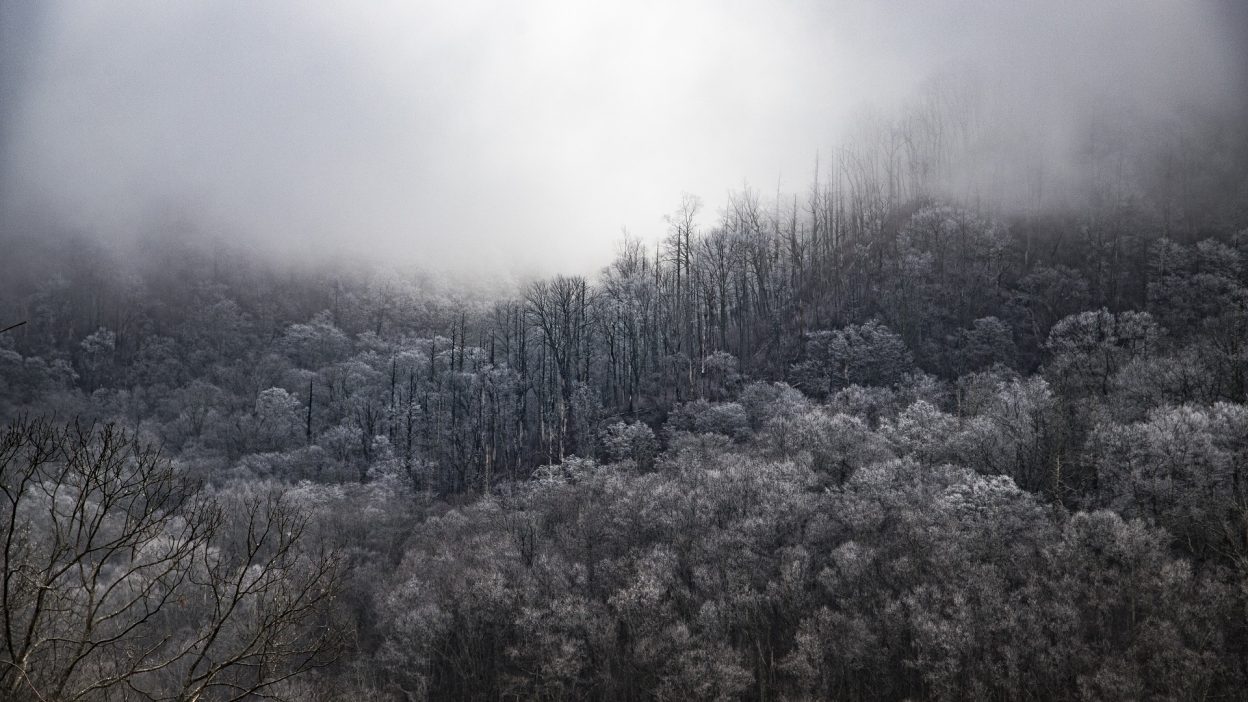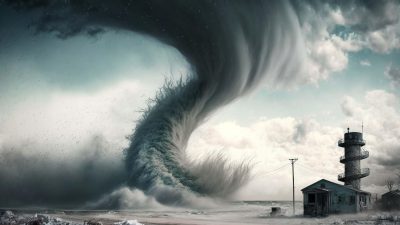A Deadly Snowstorm That Exposed America’s Vulnerability
The Great Appalachian Storm of 1950, which struck during the final days of November, remains one of the most catastrophic weather events in American history. This severe blizzard ravaged the Appalachian region, creating unparalleled devastation across several states. It unleashed a relentless mix of heavy snowfall, freezing temperatures, and fierce winds that caught many off guard, leaving entire communities isolated and unable to respond. The aftermath of the storm left an indelible mark on the region, as it revealed the fragility of the area’s infrastructure and exposed the population’s vulnerability in the face of such an overwhelming disaster. In a world before modern forecasting, the storm’s severity overwhelmed those living in the path of its fury.
The storm’s arrival was unexpected. What initially seemed to be just a typical winter storm rapidly escalated into a monstrous blizzard, catching everyone off guard. Communities in West Virginia, Kentucky, Ohio, and parts of Virginia were hit hardest by the storm’s intensity. The blizzard’s effect was immediate and crushing, with snow drifts burying homes, blocking roads, and bringing transport to a halt. What would normally have been a winter nuisance became an extraordinary, life-threatening event. As the storm intensified, it became clear that this was not just another snowstorm but an event of historic proportions.
Could the Great Appalachian Storm Have Been Foreseen? The Failure of Early Warning Systems
One of the most haunting aspects of the Great Appalachian Storm of 1950 is the realisation that it could have been better prepared for. Meteorology, as it existed in the mid-20th century, was still in its infancy. Forecasts were not nearly as precise as they are today, and weather data was gathered by hand and processed slowly, making it difficult to anticipate the storm’s intensity or path. In contrast to today’s sophisticated satellite imagery and real-time weather updates, authorities had little more than rudimentary weather reports to guide their actions.
The meteorological knowledge available at the time simply wasn’t enough to fully predict the storm’s intensity, which added to the confusion and panic. The storm had been anticipated, but its ferocity was vastly underestimated. If more advanced forecasting systems were in place, there would have been ample time to issue more comprehensive warnings to residents. However, limited understanding of how quickly the storm could intensify and the role of factors like the gulf moisture surge prevented authorities from issuing timely warnings. What authorities failed to predict were the rapidly accumulating snowfalls and the force of the winds. This lack of foresight meant many were left unprepared when the storm struck.
Devastating Human and Material Loss: Deaths, Injuries, and Destruction from the Great Appalachian Storm
- The death toll: A grim reminder of the storm’s ferocity
The Great Appalachian Storm of 1950 was tragically responsible for taking more than 350 lives. Although weather-related disasters are typically expected to cause significant loss of life, this storm was particularly deadly due to the combination of snow, wind, and extreme cold. Many lives were claimed by hypothermia, as the temperatures plummeted, and people were trapped outdoors or in unheated shelters. The deep snowdrifts that buried houses and vehicles also contributed to the death toll, as people were unable to escape their homes, and those on the road were involved in fatal accidents. The heavy snow blocked roads, making it impossible for emergency services to reach those in need. - Injuries and missing persons: A region in peril
The injuries caused by the storm were significant, with many suffering from broken bones, frostbite, and other serious health conditions. Accidents were common due to the slick, treacherous conditions, and many people found themselves trapped without access to proper medical care. The snow and ice also cut off communication lines, and many people were reported missing as search efforts were hindered by snowdrifts and downed telephone poles. Power outages added another layer of complexity to the situation, further complicating rescue operations. The cold also caused severe frostbite in many individuals who were stranded outside or in poorly heated buildings. - Infrastructure collapse and widespread damage
The storm’s ability to shut down daily life became evident as vital services collapsed. Transportation systems were completely disabled due to snow and ice, leaving people stranded in their homes or in vehicles on highways. Railways, which were essential for transporting both passengers and goods, were obstructed by the snow, further exacerbating the crisis. Airports also faced closures, and shipping lanes were rendered useless. The storm not only affected people directly but also crippled the region’s economy by halting the movement of goods and impeding recovery efforts. The snow and ice caused the collapse of buildings and power lines, leaving people without electricity for extended periods. The economic toll of the storm extended well beyond the immediate damage, as the region struggled to recover.
The Great Appalachian Storm: An Unavoidable Force of Nature or a Tragedy of Poor Preparation?
Looking back, it’s difficult to say whether the Great Appalachian Storm was an event that could have been avoided. The storm’s violence was certainly a result of natural atmospheric conditions: a clash between a cold air mass and moisture-laden winds from the Gulf of Mexico. This created a perfect storm, quite literally, of extreme weather conditions that were beyond human control. However, what is undeniable is that better preparation and improved forecasting could have significantly reduced the storm’s toll on human life and property.
While the storm itself could not have been stopped, many believe that the lack of advanced weather monitoring and response planning was a contributing factor to the disaster’s scale. With modern technology, authorities would have had greater insight into the storm’s development, allowing for quicker evacuations, better-prepared emergency services, and a more effective response overall. In hindsight, the failure to prepare adequately for the storm’s severity stands out as a major misstep. Better forecasting and early warning systems could have prevented unnecessary deaths and injuries, especially in the hardest-hit regions.
Human Resilience: How Appalachia Endured the Great Storm
Despite the tremendous loss of life and destruction, the Great Appalachian Storm also revealed the incredible resilience of the people who lived through it. While the storm’s brutality caught many off guard, it also sparked acts of human solidarity and determination. Neighbours, friends, and even strangers banded together to clear snow, rescue people trapped in their homes, and provide food and warmth to those in need.
Many stories emerged of families and communities working together to survive. People used their own resources, ingenuity, and strength to help each other during the worst of the storm. Stories of snowbound families sharing meals, farmers helping others dig out their barns, and community centres becoming hubs of shelter and safety highlighted the strength of human connection in the face of catastrophe. These acts of kindness, though small in comparison to the storm’s destructive power, helped to keep the spirit of the region alive, even as snowdrifts swallowed homes and cars.
When the Snow Fell Relentlessly: The Devastating Effects of Heavy Snowfall
The most devastating feature of the Great Appalachian Storm was the sheer amount of snowfall that the region received. In some places, snow accumulated to depths of more than 30 inches, making it impossible for people to leave their homes or travel safely. The weight of the snow created an additional threat, as roofs collapsed under the pressure, killing those trapped inside.
The snowfall’s rate of accumulation was one of the most extreme aspects of the storm. What began as a typical winter storm rapidly escalated into an overwhelming snow event. Combined with freezing temperatures, the snow soon became a killer, burying towns and blocking escape routes. The snowdrifts that formed in the aftermath created dangerous conditions, as the storm left behind not just snow but a hardened, ice-like crust that made digging out nearly impossible. Those caught outside in these conditions were at great risk, and many perished as a result.
Lessons Unlearned? The Appalachian Region’s Vulnerabilities Exposed by the 1950 Storm
The Great Appalachian Storm revealed the vulnerabilities of the region, many of which had gone unnoticed until that point. The lack of infrastructure to withstand such extreme weather became painfully clear, with major roads, bridges, and communication lines all failing to withstand the storm’s force. The rural nature of many of these areas meant that response times were slow, and relief efforts were hindered by the storm’s duration and severity.
In addition, the region’s reliance on outdated systems for everything from transportation to communication left it ill-prepared to handle such an extreme disaster. The snow blocked power lines, leaving residents without heat or light for days. Emergency services found themselves stretched thin, unable to provide aid in the most affected areas due to blocked roads and the inability to access people who were trapped. The Great Appalachian Storm made it clear that many of the region’s most vulnerable communities were woefully unprepared for a disaster of this magnitude.
Recovery and Rebuilding: The Long Road Back from the Great Appalachian Storm
In the storm’s wake, recovery was slow and painful. The damage was extensive, and it would take months for the region to fully regain its footing. The infrastructure that was damaged would need to be rebuilt, and many families faced an uncertain future as they tried to repair or replace their homes. The impact of the storm also left deep emotional scars, as many families lost loved ones, businesses, and homes to the storm’s fury.
Recovery efforts were complicated by the region’s geographic isolation and the lingering effects of the storm. Even as relief began to arrive, many communities were still dealing with the physical and emotional toll of the disaster. The storm exposed the lack of coordinated recovery efforts, and the slow pace of recovery highlighted the need for a more structured disaster response system moving forward.
5 Short FAQs
Q1: How many people were killed during the Great Appalachian Storm?
- Over 350 people lost their lives, with many others suffering injuries from accidents, frostbite, or collapsing structures.
Q2: What made the snowfall so deadly in this storm?
- The snow fell rapidly and heavily, accumulating over 30 inches in some areas. Combined with freezing temperatures, the snow trapped people indoors and caused roofs to collapse.
Q3: Could the Great Appalachian Storm have been avoided?
- While the storm itself was a natural disaster, the lack of advanced weather forecasting and preparation contributed to the extent of the damage.
Q4: What long-term effects did the storm have on Appalachia?
- The storm exposed major vulnerabilities in the region’s infrastructure and highlighted the need for improved disaster preparedness.
Q5: How did the people of Appalachia respond to the storm?
- Despite the disaster, people demonstrated incredible resilience by helping each other, clearing snow, and providing shelter to those in need.




